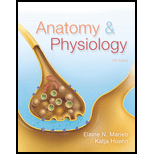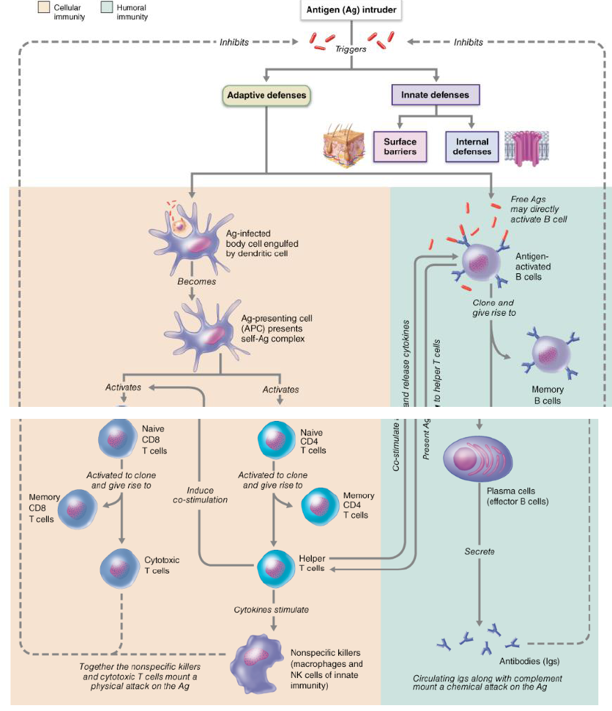
Anatomy & Physiology
5th Edition
ISBN: 9780321861580
Author: Marieb, Elaine N.
Publisher: Pearson College Div
expand_more
expand_more
format_list_bulleted
Concept explainers
Textbook Question
Chapter 20, Problem 20CYU
Describe the killing mechanism of cytotoxic T cells that involves perforins.

Figure 20.20 Simplified summary of the primary immune response.
Co-stimulation usually requires direct cell-cell interactions; cytokines enhance these and many other events. Although complement, NK cells, and phagocytes are innate defenses, they are enlisted in the fight by cytokines. (For simplicity, only B cell receptors are illustrated.)
Expert Solution & Answer
Want to see the full answer?
Check out a sample textbook solution
Students have asked these similar questions
Not part of a graded assignment, from a past midterm
Not part of a graded assignment, from a past midterm
Please answer question! Not a graded assignment, just a past midterm question
Chapter 20 Solutions
Anatomy & Physiology
Ch. 20 - What distinguishes the innate defense system from...Ch. 20 - What is the first line of defense against disease?Ch. 20 - What is opsonization and how does it help...Ch. 20 - Under what circumstances might NK cells kill our...Ch. 20 - What are the cardinal signs of inflammation and...Ch. 20 - Name three key characteristics of adaptive...Ch. 20 - What is the difference between a complete antigen...Ch. 20 - What marks a cell as self as opposed to nonselfCh. 20 - What event (or observation) signals that a B or T...Ch. 20 - Which of the following T cells would survive...
Ch. 20 - Prob. 11CYUCh. 20 - In clonal selection, who does the selecting? What...Ch. 20 - Why is the secondary response to an antigen so...Ch. 20 - Prob. 14CYUCh. 20 - Which class of antibody is most abundant in blood?...Ch. 20 - List four ways in which antibodies can bring about...Ch. 20 - Class II MHC proteins display what kind of...Ch. 20 - Prob. 18CYUCh. 20 - Which type of T cell is the most important in both...Ch. 20 - Describe the killing mechanism of cytotoxic T...Ch. 20 - Prob. 21CYUCh. 20 - Prob. 22CYUCh. 20 - Prob. 23CYUCh. 20 - All of the following are considered innate body...Ch. 20 - The process by which neutrophils squeeze through...Ch. 20 - Antibodies released by plasma cells are involved...Ch. 20 - Which of the following antibodies can fix...Ch. 20 - Which antibody class is abundant in body...Ch. 20 - Small molecules that must combine with large...Ch. 20 - Lymphocytes that develop immunocompetence in the...Ch. 20 - Cells that can directly attack target cells...Ch. 20 - Prob. 9RQCh. 20 - The cell type most often invaded by HIV is a(n)...Ch. 20 - Complement fixation promotes all of the following...Ch. 20 - Using the letters from column B, match the cell...Ch. 20 - Besides acting as mechanical barriers, the skin...Ch. 20 - Explain why attempts at phagocytosis are not...Ch. 20 - What is complement? How does it cause bacterial...Ch. 20 - Interferons are referred to as antiviral proteins....Ch. 20 - Differentiate between humoral and cellular...Ch. 20 - Although the adaptive immune system has two arms,...Ch. 20 - Define immunocompetence and self-tolerance. How is...Ch. 20 - Differentiate between a primary and a secondary...Ch. 20 - Prob. 21RQCh. 20 - What is the role of the variable regions of an...Ch. 20 - Name the five antibody classes and describe where...Ch. 20 - How do antibodies help defend the body?Ch. 20 - Do vaccines produce active or passive humoral...Ch. 20 - Prob. 26RQCh. 20 - Describe the specific roles of helper, regulatory,...Ch. 20 - Prob. 28RQCh. 20 - Prob. 29RQCh. 20 - What events can result in autoimmune disease?Ch. 20 - Prob. 1CCSCh. 20 - Prob. 2CCSCh. 20 - Prob. 3CCSCh. 20 - Prob. 4CCSCh. 20 - Prob. 5CCS
Knowledge Booster
Learn more about
Need a deep-dive on the concept behind this application? Look no further. Learn more about this topic, biology and related others by exploring similar questions and additional content below.Similar questions
- What does the heavy dark line along collecting duct tell us about water reabsorption in this individual at this time? What does the heavy dark line along collecting duct tell us about ADH secretion in this individual at this time?arrow_forwardBiology grade 10 study guidearrow_forwardI would like to see a professional answer to this so I can compare it with my own and identify any points I may have missedarrow_forward
- what key characteristics would you look for when identifying microbes?arrow_forwardIf you had an unknown microbe, what steps would you take to determine what type of microbe (e.g., fungi, bacteria, virus) it is? Are there particular characteristics you would search for? Explain.arrow_forwardavorite Contact avorite Contact favorite Contact ୫ Recant Contacts Keypad Messages Pairing ง 107.5 NE Controls Media Apps Radio Nav Phone SCREEN OFF Safari File Edit View History Bookmarks Window Help newconnect.mheducation.com M Sign in... S The Im... QFri May 9 9:23 PM w The Im... My first.... Topic: Mi Kimberl M Yeast F Connection lost! You are not connected to internet Sigh in... Sign in... The Im... S Workin... The Im. INTRODUCTION LABORATORY SIMULATION Tube 1 Fructose) esc - X Tube 2 (Glucose) Tube 3 (Sucrose) Tube 4 (Starch) Tube 5 (Water) CO₂ Bubble Height (mm) How to Measure 92 3 5 6 METHODS RESET #3 W E 80 A S D 9 02 1 2 3 5 2 MY NOTES LAB DATA SHOW LABELS % 5 T M dtv 96 J: ப 27 כ 00 alt A DII FB G H J K PHASE 4: Measure gas bubble Complete the following steps: Select ruler and place next to tube 1. Measure starting height of gas bubble in respirometer 1. Record in Lab Data Repeat measurement for tubes 2-5 by selecting ruler and move next to each tube. Record each in Lab Data…arrow_forward
arrow_back_ios
SEE MORE QUESTIONS
arrow_forward_ios
Recommended textbooks for you
 Human Physiology: From Cells to Systems (MindTap ...BiologyISBN:9781285866932Author:Lauralee SherwoodPublisher:Cengage Learning
Human Physiology: From Cells to Systems (MindTap ...BiologyISBN:9781285866932Author:Lauralee SherwoodPublisher:Cengage Learning Biology 2eBiologyISBN:9781947172517Author:Matthew Douglas, Jung Choi, Mary Ann ClarkPublisher:OpenStax
Biology 2eBiologyISBN:9781947172517Author:Matthew Douglas, Jung Choi, Mary Ann ClarkPublisher:OpenStax Human Heredity: Principles and Issues (MindTap Co...BiologyISBN:9781305251052Author:Michael CummingsPublisher:Cengage Learning
Human Heredity: Principles and Issues (MindTap Co...BiologyISBN:9781305251052Author:Michael CummingsPublisher:Cengage Learning Human Biology (MindTap Course List)BiologyISBN:9781305112100Author:Cecie Starr, Beverly McMillanPublisher:Cengage Learning
Human Biology (MindTap Course List)BiologyISBN:9781305112100Author:Cecie Starr, Beverly McMillanPublisher:Cengage Learning Biology (MindTap Course List)BiologyISBN:9781337392938Author:Eldra Solomon, Charles Martin, Diana W. Martin, Linda R. BergPublisher:Cengage Learning
Biology (MindTap Course List)BiologyISBN:9781337392938Author:Eldra Solomon, Charles Martin, Diana W. Martin, Linda R. BergPublisher:Cengage Learning

Human Physiology: From Cells to Systems (MindTap ...
Biology
ISBN:9781285866932
Author:Lauralee Sherwood
Publisher:Cengage Learning

Biology 2e
Biology
ISBN:9781947172517
Author:Matthew Douglas, Jung Choi, Mary Ann Clark
Publisher:OpenStax

Human Heredity: Principles and Issues (MindTap Co...
Biology
ISBN:9781305251052
Author:Michael Cummings
Publisher:Cengage Learning

Human Biology (MindTap Course List)
Biology
ISBN:9781305112100
Author:Cecie Starr, Beverly McMillan
Publisher:Cengage Learning

Biology (MindTap Course List)
Biology
ISBN:9781337392938
Author:Eldra Solomon, Charles Martin, Diana W. Martin, Linda R. Berg
Publisher:Cengage Learning

Immune System and Immune Response Animation; Author: Medical Sciences Animations;https://www.youtube.com/watch?v=JDdbUBXPKc4;License: Standard YouTube License, CC-BY
Immune response: summary; Author: Dr Bhavsar Biology;https://www.youtube.com/watch?v=ADANgHkX4OY;License: Standard Youtube License